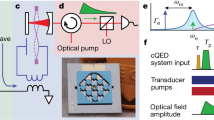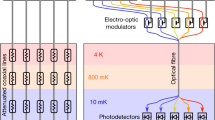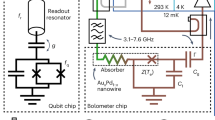Abstract
Engineered macroscopic quantum systems based on superconducting electronic circuits are attractive for experimentally exploring diverse questions in quantum information science1,2,3. At the current state of the art, quantum bits (qubits) are fabricated, initialized, controlled, read out and coupled to each other in simple circuits. This enables the realization of basic logic gates4, the creation of complex entangled states5,6 and the demonstration of algorithms7 or error correction8. Using different variants of low-noise parametric amplifiers9, dispersive quantum non-demolition single-shot readout of single-qubit states with high fidelity has enabled continuous10 and discrete11 feedback control of single qubits. Here we realize full deterministic quantum teleportation with feed-forward in a chip-based superconducting circuit architecture12,13,14. We use a set of two parametric amplifiers for both joint two-qubit and individual qubit single-shot readout, combined with flexible real-time digital electronics. Our device uses a crossed quantum bus technology that allows us to create complex networks with arbitrary connecting topology in a planar architecture. The deterministic teleportation process succeeds with order unit probability for any input state, as we prepare maximally entangled two-qubit states as a resource and distinguish all Bell states in a single two-qubit measurement with high efficiency and high fidelity. We teleport quantum states between two macroscopic systems separated by 6 mm at a rate of 104 s−1, exceeding other reported implementations. The low transmission loss of superconducting waveguides is likely to enable the range of this and other schemes to be extended to significantly larger distances, enabling tests of non-locality and the realization of elements for quantum communication at microwave frequencies. The demonstrated feed-forward may also find application in error correction schemes.
This is a preview of subscription content, access via your institution
Access options
Subscribe to this journal
Receive 51 print issues and online access
$199.00 per year
only $3.90 per issue
Buy this article
- Purchase on Springer Link
- Instant access to full article PDF
Prices may be subject to local taxes which are calculated during checkout



Similar content being viewed by others
References
Clarke, J. & Wilhelm, F. K. Superconducting quantum bits. Nature 453, 1031–1042 (2008)
Houck, A. A., Tureci, H. E. & Koch, J. On-chip quantum simulation with superconducting circuits. Nature Phys. 8, 292–299 (2012)
Devoret, M. & Schoelkopf, R. J. Superconducting circuits for quantum information: an outlook. Science 339, 1169–1174 (2013)
Steffen, M. et al. Measurement of the entanglement of two superconducting qubits via state tomography. Science 313, 1423–1425 (2006)
DiCarlo, L. et al. Preparation and measurement of three-qubit entanglement in a superconducting circuit. Nature 467, 574–578 (2010)
Neeley, M. et al. Generation of three-qubit entangled states using superconducting phase qubits. Nature 467, 570–573 (2010)
DiCarlo, L. et al. Demonstration of two-qubit algorithms with a superconducting quantum processor. Nature 460, 240–244 (2009)
Reed, M. D. et al. Realization of three-qubit quantum error correction with superconducting circuits. Nature 482, 382–385 (2012)
Castellanos-Beltran, M. A., Irwin, K. D., Hilton, G. C., Vale, L. R. & Lehnert, K. W. Amplification and squeezing of quantum noise with a tunable Josephson metamaterial. Nature Phys. 4, 929–931 (2008)
Vijay, R. et al. Stabilizing Rabi oscillations in a superconducting qubit using quantum feedback. Nature 490, 77–80 (2012)
Johnson, J. E. et al. Heralded state preparation in a superconducting qubit. Phys. Rev. Lett. 109, 050506 (2012)
Wallraff, A. et al. Strong coupling of a single photon to a superconducting qubit using circuit quantum electrodynamics. Nature 431, 162–167 (2004)
Helmer, F. et al. Cavity grid for scalable quantum computation with superconducting circuits. Europhys. Lett. 85, 50007 (2009)
Mariantoni, M. et al. Implementing the quantum von Neumann architecture with superconducting circuits. Science 334, 61–65 (2011)
Bennett, C. H. et al. Teleporting an unknown quantum state via dual classical and Einstein–Podolsky–Rosen channels. Phys. Rev. Lett. 70, 1895–1899 (1993)
Gisin, N., Ribordy, G., Tittel, W. & Zbinden, H. Quantum cryptography. Rev. Mod. Phys. 74, 145–195 (2002)
Gottesman, D. & Chuang, I. L. Demonstrating the viability of universal quantum computation using teleportation and single-qubit operations. Nature 402, 390–393 (1999)
Massar, S. & Popescu, S. Optimal extraction of information from finite quantum ensembles. Phys. Rev. Lett. 74, 1259–1263 (1995)
Bouwmeester, D. et al. Experimental quantum teleportation. Nature 390, 575–579 (1997)
Ma, X.-S. et al. Quantum teleportation over 143 kilometres using active feed-forward. Nature 489, 269–273 (2012)
Kim, Y. H., Kulik, S. P. & Shih, Y. Quantum teleportation of a polarization state with a complete Bell state measurement. Phys. Rev. Lett. 86, 1370–1373 (2001)
Furusawa, A. et al. Unconditional quantum teleportation. Science 282, 706–709 (1998)
Riebe, M. et al. Deterministic quantum teleportation with atoms. Nature 429, 734–737 (2004)
Barrett, M. et al. Deterministic quantum teleportation of atomic qubits. Nature 429, 737–739 (2004)
Olmschenk, S. et al. Quantum teleportation between distant matter qubits. Science 323, 486–489 (2009)
Bao, X.-H. et al. Quantum teleportation between remote atomic-ensemble quantum memories. Proc. Natl Acad. Sci. USA 109, 20347–20351 (2012)
Baur, M. et al. Benchmarking a quantum teleportation protocol in superconducting circuits using tomography and an entanglement witness. Phys. Rev. Lett. 108, 040502 (2012)
Filipp, S. et al. Two-qubit state tomography using a joint dispersive readout. Phys. Rev. Lett. 102, 200402 (2009)
Chuang, I. L. & Nielsen, M. A. Prescription for experimental determination of the dynamics of a quantum black box. J. Mod. Opt. 44, 2455–2467 (1997)
Eichler, C. et al. Observation of two-mode squeezing in the microwave frequency domain. Phys. Rev. Lett. 107, 113601 (2011)
Koch, J. et al. Charge-insensitive qubit design derived from the Cooper pair box. Phys. Rev. A 76, 042319 (2007)
Göppl, M. et al. Coplanar waveguide resonators for circuit quantum electrodynamics. J. Appl. Phys. 104, 113904 (2008)
Fink, J. M. et al. Dressed collective qubit states and the Tavis–Cummings model in circuit QED. Phys. Rev. Lett. 103, 083601–083604 (2009)
Motzoi, F., Gambetta, J. M., Rebentrost, P. & Wilhelm, F. K. Simple pulses for elimination of leakage in weakly nonlinear qubits. Phys. Rev. Lett. 103, 110501 (2009)
Gambetta, J. M., Motzoi, F., Merkel, S. T. & Wilhelm, F. K. Analytic control methods for high-fidelity unitary operations in a weakly nonlinear oscillator. Phys. Rev. A 83, 012308 (2011)
Chow, J. M. et al. Randomized benchmarking and process tomography for gate errors in a solid-state qubit. Phys. Rev. Lett. 102, 090502 (2009)
Strauch, F. W. et al. Quantum logic gates for coupled superconducting phase qubits. Phys. Rev. Lett. 91, 167005 (2003)
Vijay, R., Slichter, D. H. & Siddiqi, I. Observation of quantum jumps in a superconducting artificial atom. Phys. Rev. Lett. 106, 110502 (2011)
Eichler, C. & Wallraff, A. Controlling the dynamic range of a Josephson parametric amplifier. arXiv:1305.6583 (2013)
Nölleke, C. et al. Efficient teleportation between remote single-atom quantum memories. Phys. Rev. Lett. 110, 140403 (2013)
Ristè, D., van Leeuwen, J. G., Ku, H.-S., Lehnert, K. W. & DiCarlo, L. Initialization by measurement of a superconducting quantum bit circuit. Phys. Rev. Lett. 109, 050507 (2012)
Ristè, D., Bultink, C. C., Lehnert, K. W. & DiCarlo, L. Feedback control of a solid-state qubit using high-fidelity projective measurement. Phys. Rev. Lett. 109, 240502 (2012)
Murch, K. W. et al. Cavity-assisted quantum bath engineering. Phys. Rev. Lett. 109, 183602 (2012)
Geerlings, K. et al. Demonstrating a driven reset protocol for a superconducting qubit. Phys. Rev. Lett. 110, 120501 (2013)
Campagne-Ibarcq, P. et al. Persistent control of a superconducting qubit by stroboscopic measurement feedback. Phys. Rev. X 3, 021008 (2013)
van Enk, S. J., Lütkenhaus, N. & Kimble, H. J. Experimental procedures for entanglement verification. Phys. Rev. A 75, 052318 (2007)
Acknowledgements
We thank A. Blais, F. Marquardt, S. Filipp and R. Renner for discussion and feedback; and J. Heinsoo, L. Heinzle, A. Landig, Y. Liu, F. Lüthi and T. Menke for technical contributions to the experimental work. This work was supported financially by Eidgenössische Technische Hochschule Zurich (ETH Zurich), the EU Integrated Projects SOLID and SCALEQIT, and the Swiss National Science Foundation’s National Centre of Competence in Research ‘Quantum Science & Technology’.
Author information
Authors and Affiliations
Contributions
The experiments were performed by L.S., A.F., Y.S., M.O., P.K. and M.B. The teleportation sample and parametric amplifiers were fabricated by A.F., L.S. and M.B. The air-bridge technology was developed by G.P.-H. and L.S. The FPGA firmware was implemented by Y.S. and C.L. The parametric amplifiers were designed by C.E., who also oversaw their operation. The manuscript was written by L.S., A.F. and A.W. All authors commented on the manuscript. The project was led by A.F. and A.W.
Corresponding authors
Ethics declarations
Competing interests
The authors declare no competing financial interests.
Extended data figures and tables
Extended Data Figure 1 Pulse sequence of the teleportation protocol with feed-forward.
The pulses implement the creation of an entangled pair between Q2 and Q3 (blue), the preparation of the state to be teleported on Q1 (green), the basis transformation from the Bell to the computational basis and the subsequent readout of Q1 and Q2 (red), the dynamical decoupling (DD) pulses, conditional rotations and the state tomography on Q3 (green). Gaussian-shaped sinusoids represent the microwave pulses applied to the respective charge bias lines of the qubits; sinusoids on the resonators represent the readout tones; and the squares labelled cphase represent the flux pulses that shift the frequency of a qubit to implement a controlled-phase gate between the marked qubits, where the interaction is mediated through the resonator indicated with a bar of the same colour as the flux pulse. The inset shows the time used for implementing the conditional feed-forward rotations. The total feed-forward time is the sum of the ramp-up time of the measurement tone, the integration time of the measurement signal and the delay times induced by the FPGA signal processing, the AWG trigger and the cables.
Extended Data Figure 2 Characterization of the joint readout of Q1 and Q2.
a, Histogram of the integrated signal quadrature-amplitude amplified phase-sensitively when preparing the states |00〉 (blue), |01〉 (red), |10〉 (yellow) and |11〉 (green). b, Scatter plot of integrated (I, Q) quadratures of the measurement signal amplified in the phase-preserving mode when preparing the states |00〉 (blue), |01〉 (red), |10〉 (yellow) and |11〉 (green).
Extended Data Figure 3 Characterization of the output states.
Real (blue) and imaginary (red) parts of the reconstructed density matrices of the state |ψout〉 for the indicated input states |ψin〉 obtained from state tomography when (a) post-selecting data on a 00 outcome of the Bell measurement (b) using averaged readout on Q3 while performing fully deterministic teleportation with feed-forward. The ideally expected outcomes are indicated with wireframes. The state fidelities are indicated in the black boxes.
Rights and permissions
About this article
Cite this article
Steffen, L., Salathe, Y., Oppliger, M. et al. Deterministic quantum teleportation with feed-forward in a solid state system. Nature 500, 319–322 (2013). https://doi.org/10.1038/nature12422
Received:
Accepted:
Published:
Issue Date:
DOI: https://doi.org/10.1038/nature12422
This article is cited by
-
Encoding a magic state with beyond break-even fidelity
Nature (2024)
-
Short-Distance Bidirectional Teleportation for Arbitrary Unknown Single-Qutrit States in Noise Environment
International Journal of Theoretical Physics (2024)
-
Enhancing quantum teleportation efficacy with noiseless linear amplification
Nature Communications (2023)
-
Realizing a deep reinforcement learning agent for real-time quantum feedback
Nature Communications (2023)
-
Quantum Teleportation of the Entangled Superconducting Qubits via LC Resonators
International Journal of Theoretical Physics (2023)
Comments
By submitting a comment you agree to abide by our Terms and Community Guidelines. If you find something abusive or that does not comply with our terms or guidelines please flag it as inappropriate.



